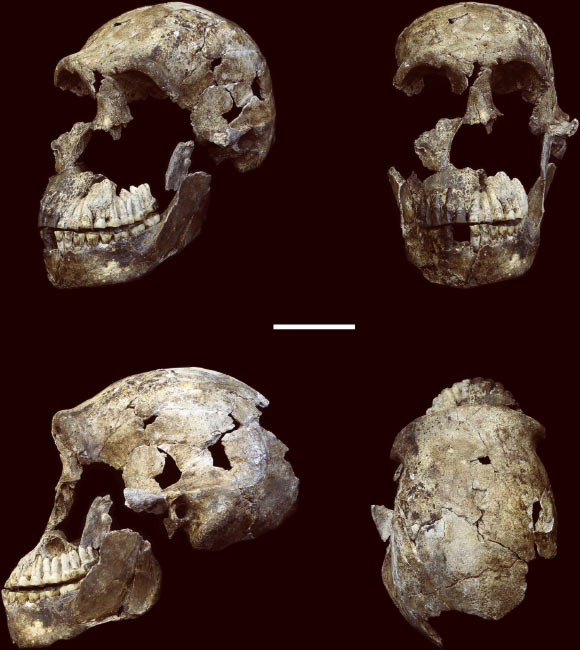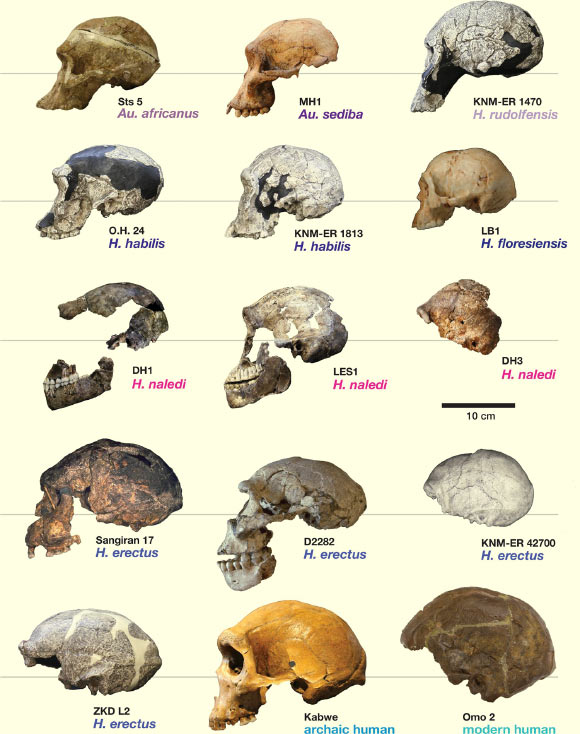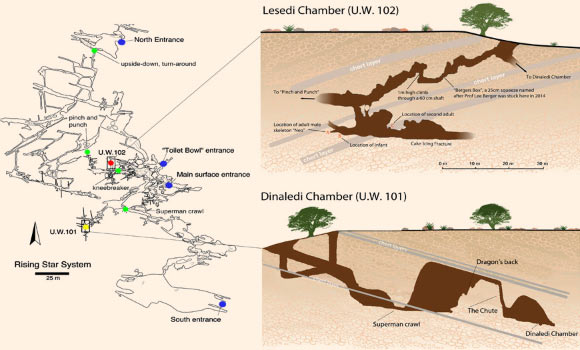An international team of paleoanthropologists announced today in the journal eLife the discovery of a second chamber in the Rising Star cave system, located outside of Johannesburg, South Africa, in the Cradle of Humankind World Heritage Site, containing additional specimens of a recently discovered human relative, Homo naledi.

A Homo naledi skull, ‘Neo.’ Clockwise from upper left: three-quarter, frontal, superior and left lateral views. Scale bar – 5 cm. Image credit: Hawks et al, doi: 10.7554/eLife.24232.
The new chamber, dubbed the Lesedi Chamber (means ‘light’ in the Setswana language), is about 330 feet (100 m) from the remote, nearly inaccessible Dinaledi Chamber where the first Homo naledi fossils representing at least 15 individuals were found.
The chamber is 98 feet (30 m) below the surface and there is no direct route between it and the Dinaledi Chamber. It is also exceedingly difficult to access, requiring those excavating the fossils to crawl, climb and squeeze their way in pitch dark to the fossil cache.
“To access the Lesedi Chamber is only slightly easier than the Dinaledi Chamber. After passing through a squeeze of about 10 inches (25 cm), you have to descend along vertical shafts before reaching the chamber,” said co-author Dr. Marina Elliott, an exploration scientist at the University of Witwatersrand.
“While slightly easier to get to, the Lesedi Chamber is, if anything, more difficult to work in due to the tight spaces involved.”
“The presence of a second chamber, distant from the first, containing multiple individuals of Homo naledi and almost as difficult to reach as the Dinaledi Chamber, gives an idea of the extraordinary effort it took for Homo naledi to reach these hard-to-get-to places,” said co-author Dr. Hannah Hilbert-Wolf, a geologist at James Cook University.
So far, the researchers have retrieved 133 new Homo naledi fossils from the Lesedi Chamber.
Also like the Dinaledi Chamber, no remains of other ancient humans or their relatives were found.
“The discovery of the new fossils representing the remains of at least three individuals includes a ‘wonderfully complete skull’,” said lead author John Hawks, the Vilas-Borghesi distinguished achievement professor of anthropology at the University of Wisconsin-Madison.
“Finding more remains of multiple individuals in a chamber some distance from the chamber containing the original Homo naledi fossils lends heft to the idea that Homo naledi was caching its dead — a surprising behavior that suggests great intelligence and possibly the first stirrings of culture.”
“What is so provocative about Homo naledi is that these are creatures with brains one third the size of ours,” he added.
“This is clearly not a human, yet it seems to share a very deep aspect of behavior that we recognize, an enduring care for other individuals that continues after their deaths. It awes me that we may be seeing the deepest roots of human cultural practices.”
The new fossils come from two adults and a child, and the scientists believe more will be recovered as excavations progress.
The child, estimated to be under five years of age, is represented by bones from the head and body. Of the adults, one is identified only by a jaw and leg bones.
The skeleton of the third individual, dubbed ‘Neo’ (Sesotho word meaning ‘a gift’), is remarkably complete.

Comparison of Homo naledi skulls to skulls of other hominin species. Image credit: Hawks et al, doi: 10.7554/eLife.24232.
“With the new fossils from the Lesedi Chamber, we now have approximately 2,000 specimens of Homo naledi, representing the skeletons of at least 18 individuals,” Prof. Hawks said.
“There are more Homo naledi specimens than any other extinct species or population of hominins except for Neanderthals.”
“The skeleton of ‘Neo’ is one of the most complete ever discovered, technically more complete than the famous Lucy fossil given the preservation of the skull and mandible,” said senior author Prof. Lee Berger, a noted paleoanthropologist from the University of Witwatersrand.
“The skull of the new skeleton has much of the face, including the delicate bones of the inner eye region and nose. Some of the new bones add detail to what we knew before,” Prof. Hawks said.
“We finally get a look at the face of Homo naledi,” added co-author Dr. Peter Schmid, of the University of Witwatersrand and the University of Zurich.
“The ‘Neo’ skeleton has a complete collarbone and a near-complete femur, which help to confirm what we knew about the size and stature of Homo naledi, and that it was both an effective walker and climber,” Prof. Hawks said.
“The vertebrae are just wonderfully preserved, and unique — they have a shape we’ve only seen in Neanderthals.”
“Our skeletal and dental analysis of Homo naledi vastly expands and extends our knowledge of the make-up and variation of this enigmatic new species,” said co-author Dr. Shara Bailey, an associate professor of anthropology at New York University.
“Associated partial skeletons of fossil hominins are extremely rare in the fossil record,” added co-author Dr. Scott Williams, also from New York University.
_____
John Hawks et al. 2017. New fossil remains of Homo naledi from the Lesedi Chamber, South Africa. eLife 6: e24232; doi: 10.7554/eLife.24232








